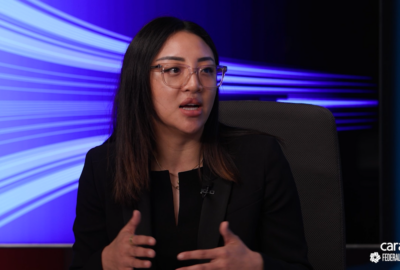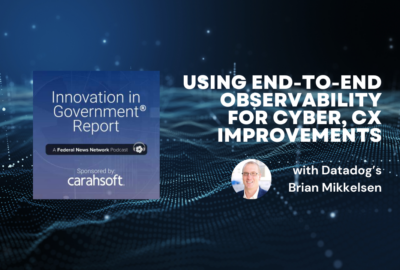Insight by Docusign
High-Impact Service Providers leading a digital-first CX transformation across government
OMB’s digital-first guidance instructs agencies to design products and services with user experience in mind.
The federal government delivers information and services to more than 400 million individuals, businesses and organizations every year.
The White House estimates more than 400 agencies and their component offices provide these public-facing services. But only a small fraction – less than 40 agencies and programs — are considered High-Impact Service Providers (HISPs).
Erica Fensom, vice president of corporate affairs at Docusign, says HISPs are leading the way for agencies to provide a better, digital-first customer experience across the federal government.
“Investments can only make an impact if they’re effectively scaled. And the reason that HISPs are important is because they play such an important role in delivering constituent-facing services. There are so many different opportunities to improve those points of connection with your constituents,” Fensom said. “If you take a look at most public services, and the delivery of those, there’s one common thing in there, which is a constituent requesting a service or applying for a benefit, or doing some other action, where there is a form of agreement. That’s really one of the ways that agencies can scale, is to take a look at those common activities that happen across your constituent-facing services, and really hone in on those areas of agreement to make that experience better.”
Providing a ‘digital-first’ customer experience
The Office of Management and Budget, in its recent guidance on delivering a “digital-first public experience,” said a majority of the public accesses government services online, and that a growing segment of that traffic comes from mobile devices.
“Citizens and constituents expect that there will be a really good mobile experience, that it will be seamless, and that it will be easy to understand and navigate,” Fensom said. “How is this going to look and feel on a mobile device? What are the different omnichannel ways that this constituent might want to communicate with me and make sure that they all work together?”
OMB’s digital-first guidance instructs agencies to design products and services with user experience in mind. It’s also directed agencies to make digital services improvements that are accessible to users with a range of disabilities.
In the latest governmentwide assessment, OMB and the General Services Administration found about three-quarters of agencies are struggling with digital accessibility requirements under Section 508 of the Rehabilitation Act.
“There’s huge opportunity to improve there. High-Impact Service Providers are rooted in transforming our customer experience,” Fensom said. “This is how we’re going to be able to create that great digital experience for everyone, including people of diverse abilities.”
OMB’s recent policies build on progress that began in December 2018, when Congress passed the 21st Century Integrated Digital Experience Act (IDEA).
Among its requirements, the legislation tasked agencies with modernizing their websites, and accelerating the use of electronic signatures across the federal government.
E-signatures driving CX improvements
Fensom said the rollout of electronic signatures across government is streamlining backend processes and reducing errors.
A federal agency working with Docusign, she added, previously spent up to 99 days to process one of its internal documents. But by moving the form online and adding an electronic signature, the agency has been able to reduce that processing time to 17 days.
Another Docusign client, reduced errors in their system by 90% by moving to a digital workflow.
“We’re working with our partners in discovering more and more areas where there are forms and paper processes in government that could be done electronically. And if you think about those high- impact and frequent use cases that happen within government, it’s applying for service. It’s applying for a benefit,” Fensom said.
Docusign, she added, worked with a third agency last year to streamline the application process for debt relief eligibility.
That HISP agency transformed its front-end application process by rolling out electronic signatures for two of its forms.
“They made it easy for claimants to submit their applications and reduce their previous processing delays caused by mailing an application. Imagine you have thousands of applicants who are mailing in applications. The agency had to wait for those to come in, then process all this paper manually,” Fensom said. “There’re huge benefits in terms of time savings, resource savings, but most importantly, the service was a better experience for the claimants. So that is really exciting. And by rolling out electronic signatures, the agency was able to confirm the identity of the signer, ensure the services were going to the correct individual, and save not only time, but resources and deliver a better experience.”
Rebuilding trust through CX improvements
The Biden administration sees HISPs and their ongoing work to improve public-facing services as an opportunity to rebuild Americans’ trust in government institutions.
“Trust is incredibly important. It’s at the nexus of experiences and security. And so, no matter what area you’re looking at, when you’re delivering a public service, trust has to be number one and at the forefront. To build and maintain trust with the public, having a really strong customer experience is also part of building that trust. That constituent experience of, ‘If I fill in my information, will I know that this is secure, that it’s going into the right system, that I’ll be able to get the right benefit that I’m applying for,’ all of those are elements of trust,” Fensom said.
While HISPs see plenty of work ahead to improve service delivery across government, Fensom said OMB’s policy roadmap gives them a clear direction on what progress looks like.
“I see a huge amount of momentum ahead. I see agencies really leaning in and wanting to understand, how can I adopt these new technologies? And there are a lot of areas where it could feel like there’s some internal hurdles. How do we change our policies so that electronic signatures, digital forms and agreements are more easily accepted?” Fensom said. “I’m excited that the OMB guidance has made it very clear to agencies that there is a mandate for change, there’s a mandate to focus on your customer experience. And there are resources to help you.”
Discover more about how to elevate your customer experience in the “Excellent, equitable and secure customer experience: A closer look at high-impact service providers” series.
Copyright © 2025 Federal News Network. All rights reserved. This website is not intended for users located within the European Economic Area.
Jory Heckman is a reporter at Federal News Network covering U.S. Postal Service, IRS, big data and technology issues.
Follow @jheckmanWFED






